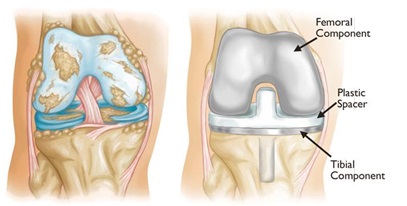
A total knee replacement is a surgical procedure whereby the diseased knee joint is replaced with artificial material. It is also known as knee arthroplasty, is one of the most common types of elective surgery. The knee is a hinge joint which provides motion at the point where the thigh meets the lower leg. The thighbone (or femur) abuts the large bone of the lower leg (tibia) at the knee joint. The end of the lower leg bone (tibia) is also removed and replaced with a channeled plastic piece with a metal stem. Depending on the condition of the kneecap portion of the knee joint, a plastic "button" may also be added under the kneecap surface.
In total knee replacement surgery, this ligament is either retained, sacrificed, or substituted by a polyethylene post. Each of these various designs of total knee replacement has its own particular benefits and risks.
Total knee replacement surgery is considered for patients whose knee joints have been damaged by either progressive arthritis, trauma, or other rare destructive diseases of the joint. The most common reason for knee replacement in the United States is severe osteoarthritis of the knees. Regardless of the cause of the damage to the joint, the resulting progressively increasing pain and stiffness and decreasing daily function lead the patient to consider total knee replacement.
If your knee is severely damaged by arthritis or injury, it may be hard for you to perform simple activities, such as walking or climbing stairs. You may even begin to feel pain while you are sitting or lying down.

If nonsurgical treatments like medications and using walking supports are no longer helpful, you may want to consider total knee replacement surgery. Joint replacement surgery is a safe and effective procedure to relieve pain, correct leg deformity, and help you resume normal activities.
Partial knee replacements have been around for decades and offer excellent clinical results, just like total knee replacements. Less invasive techniques are available to insert these smaller implants but only a minority of knee replacement patients (about 10%) are good candidates for this procedure.
